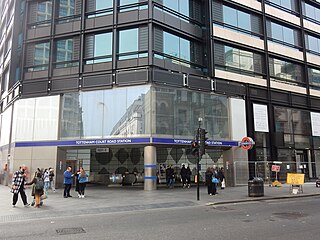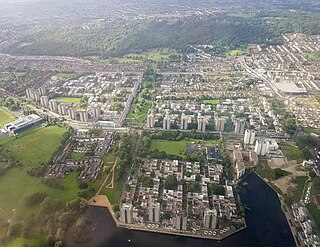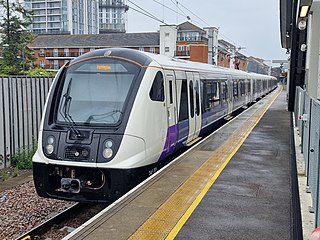Related Research Articles

Liverpool Street station, also known as London Liverpool Street, is a major central London railway terminus and connected London Underground station in the north-eastern corner of the City of London, in the ward of Bishopsgate Without. It is the terminus of the West Anglia Main Line to Cambridge, the Great Eastern Main Line to Norwich, commuter trains serving east London and destinations in the East of England, and the Stansted Express service to Stansted Airport.

Tottenham Court Road is an interchange station located in St Giles in the West End of London for London Underground and Elizabeth line services.

Crossrail was a railway construction project centred around London. It aimed to provide a high-frequency hybrid commuter rail and rapid transit system crossing the capital from suburbs on the west to east, by connecting two major railway lines terminating in London: the Great Western Main Line and the Great Eastern Main Line. The project was approved in 2007, and construction began in 2009 on the central section and connections to existing lines that became part of the route, which has been named the Elizabeth line in honour of Queen Elizabeth II who opened the line on 17 May 2022 during her Platinum Jubilee. The central section of the line between Paddington and Abbey Wood opened on 24 May 2022, with 12 trains per hour running in each direction through the core section in Central London.

Bond Street is an interchange station in Mayfair, in the West End of London for London Underground and Elizabeth line services. Entrances are on Oxford Street, near its junction with New Bond Street, and on Hanover Square.
Farringdon is a small district in Central London, the southern part of the London Borough of Islington. The term is used to describe the area around Farringdon station. Historically the district corresponded to southern Clerkenwell and the small parish of St Sepulchre Middlesex.

Southall is a railway station on the Great Western Main Line in Southall, London, England. It is in Travelcard Zone 4 and passenger services are provided by the Elizabeth line from London Paddington. It is 9 miles 6 chains (14.6 km) down the line from Paddington and is situated between Hanwell to the east and Hayes & Harlington to the west.

St Olave's Church, Hart Street, is a Church of England church in the City of London, located on the corner of Hart Street and Seething Lane near Fenchurch Street railway station.
Sir William Laxton was a Lord Mayor of London during the reign of Henry VIII, and eight times Master of the Worshipful Company of Grocers. He is the founder of Oundle School.

Maidenhead railway station serves the market town of Maidenhead, Berkshire, England. It is 24 miles 19 chains (39.0 km) down the line from London Paddington and is situated between Taplow to the east and Twyford to the west.

Abbey Wood is an area in southeast London, England, straddling the border between the Royal Borough of Greenwich and the London Borough of Bexley. It is located 10.6 miles (17 km) east of Charing Cross.

Charterhouse Square is a garden square, a pentagonal space, in Farringdon, in the London Borough of Islington, and close to the former Smithfield Meat Market. The square is the largest courtyard or yard associated with the London Charterhouse, mostly formed of Tudor and Stuart architecture restored after the London Blitz. The square adjoins other buildings including a small school. It lies between Charterhouse Street, Carthusian Street and the main Charterhouse complex of buildings south of Clerkenwell Road. The complex includes a Chapel, Tudor Great Hall, Great Chamber, the Barts and The London School of Medicine and Dentistry and a 40-resident almshouse.
Events from the 1570s in England.
Sir Richard Martin was an English goldsmith and Master of the Mint who served as Sheriff and twice as Lord Mayor of the City of London during the reign of Elizabeth I.
Sir William Spring of Lavenham was an English politician and landowner.

The British Rail Class 345 Aventra is a fleet of electric multiple unit passenger trains built by Bombardier Transportation for use on London's Elizabeth line. Part of Bombardier's Aventra family of trains, the contract for their delivery was awarded as part of the Crossrail project in February 2014. A total of 70 nine-car units – each able to carry 1,500 passengers – were constructed in Derby between 2015 and 2019, at a cost of over £1 billion. The first unit entered service on 22 June 2017.

The English coastal city of Brighton and Hove, made up of the formerly separate Boroughs of Brighton and Hove in East Sussex, has a wide range of cemeteries throughout its urban area. Many were established in the mid-19th century, a time in which the Victorian "cult of death" encouraged extravagant, expensive memorials set in carefully cultivated landscapes which were even recommended as tourist attractions. Some of the largest, such as the Extra Mural Cemetery and the Brighton and Preston Cemetery, were set in particularly impressive natural landscapes. Brighton and Hove City Council, the local authority responsible for public services in the city, manages seven cemeteries, one of which also has the city's main crematorium. An eighth cemetery and a second crematorium are owned by a private company. Many cemeteries are full and no longer accept new burials. The council maintains administrative offices and a mortuary at the Woodvale Cemetery, and employs a coroner and support staff.
Sir Matthew Browne of Betchworth Castle, Surrey, MP, was the only son of Sir Thomas Browne and Mabel Fitzwilliam. He was involved in legal and financial transactions concerning the Globe Theatre in 1601. He was killed in a duel with his kinsman, Sir John Townshend, on 1 August 1603.

The New Churchyard was a municipal and non-parochial burial ground in London. Established in 1569, it was used for burial from 1570 until 1739, by which date approximately 25,000 interments were estimated to have taken place. It was created to accommodate the ever-increasing number of new interments required as London's population expanded during 16th to 18th centuries. It was known as a "churchyard" despite not being associated with a church and, from the mid-17th century, became more commonly known as Bedlam or Bethlem burial ground because its location within the "Bedlam" or "Bethlem" area. The remains of the burial ground are now located under modern Liverpool Street, within the north-east corner of the City of London.

The Elizabeth line is a high-frequency hybrid urban–suburban rail service in London and its suburbs. It runs services on dedicated infrastructure in central London from the Great Western Main Line west of Paddington station to Abbey Wood and via Whitechapel to the Great Eastern Main Line near Stratford; along the Great Western Main Line to Reading and Heathrow Airport in the west; and along the Great Eastern Main Line to Shenfield in the east. The service is named after Queen Elizabeth II, who officially opened the line on 17 May 2022 during her Platinum Jubilee year; passenger services started on 24 May 2022. Despite being named under the same system as London Underground lines, and having sections which are underground, the Elizabeth line is not classified as a London Underground line.
The Crossrail line was first proposed in 1941. It was first proposed to Parliament in 1991 but was rejected. It was then proposed by the government as the Crossrail bill in 2005. Construction started in 2009 and, heavily delayed, the central section was opened by Elizabeth II on 24 May 2022 with full completion due in 2023.
References
- ↑ John Stow (1842). A survey of London. Whittaker and co. pp. 195–.
- ↑ W. K. Jordan (28 October 2013). The Charities of London, 1480 - 1660: The Aspirations and the Achievements of the Urban Society. Routledge. pp. 143–. ISBN 978-1-135-65672-0.
- ↑ "Bedlam burials: Thousands of skeletons to be unearthed". BBC News. 9 February 2015. Retrieved 9 February 2015.
- ↑ "Bedlam Burial Register". Crossrail. Archived from the original on 11 February 2015. Retrieved 25 January 2018.
- ↑ The National Archives, PROB 11/60/296